
Snowboards are boards where the user places both feet, usually secured, to the same board. The board itself is wider than most skis, with the ability to glide on snow. Snowboards widths are between 6 and 12 inches or 15 to 30 centimeters. Snowboards are differentiated from monoskis by the stance of the user. In monoskiing, the user stands with feet inline with direction of travel, whereas in snowboarding, users stand with feet transverse to the longitude of the board. Users of such equipment may be referred to as snowboarders. Commercial snowboards generally require extra equipment such as bindings and special boots which help secure both feet of a snowboarder, who generally ride in an upright position. These types of boards are commonly used by people at ski hills, mountains, backcountry, or resorts for leisure, entertainment, and competitive purposes in the activity called snowboarding.
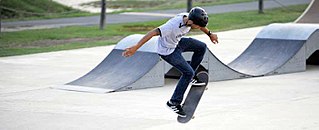
A skateboarding trick, or simply a trick, is a maneuver performed by manipulating a skateboard, usually with one's feet, in a specific way to achieve the desired outcome – the trick.

The kickflip is a skateboarding trick, in which the rider flips their skateboard 360° along the axis that extends from the nose to the tail of the deck. When the rider is regular footed the board spins counter-clockwise if viewed from the side.

An Indy grab, also known as an Indy air, is an aerial skateboarding, snowboarding and kitesurfing trick during which the rider grabs their back hand on the middle of their board, between their feet, on the side of the board where their toes are pointing, while turning backside. This trick is done only backside; the same maneuver done while turning front side, is called a front side air. The Indy grab is a generic skateboarding trick that has been performed since the late 1970s. This trick is performed mainly while vert skating, e.g. on halfpipes. Although this move can be done on flat land, it is much easier on a ramp. The Indy grab is one of the basic tricks in vert skating and is usually combined with spins, kickflips and heelflips.
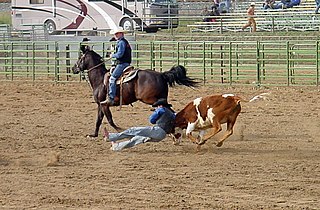
Steer wrestling, also known as bulldogging, is a rodeo event in which a horse-mounted rider chases a steer, drops from the horse to the steer, then wrestles the steer to the ground by grabbing its horns and pulling it off-balance so that it falls to the ground. The event carries a high risk of injury to the cowboy. Some concerns from the animal-rights community express that the competition may include practices that constitute cruelty to animals, but the injury rate to animals is less than 0.05%. A later PRCA survey of 60,971 animal performances at 198 rodeo performances and 73 sections of "slack" indicated 27 animals were injured, again around 0.05%.

Kiteboarding or kitesurfing is a sport that involves using wind power with a large power kite to pull a rider across a water, land, or snow surface. It combines the aspects of paragliding, surfing, windsurfing, skateboarding, snowboarding, and wakeboarding. Kiteboarding is among the less expensive and more convenient sailing sports.

Kneeboarding is an aquatic sport where the participant is towed on a buoyant, convex, and hydrodynamically shaped board at a planing speed, most often behind a motorboat. Kneeboarding on a surf style board with fin(s) is also done in waves at the beach. In the usual configuration of a tow-sport kneeboard, riders kneel on their heels on the board, and secure themselves to the deck with an adjustable Velcro strap over their thighs. Most water ski kneeboards do not have fins to allow for easier surface spins. As in wakeboarding or water skiing, the rider hangs onto a tow-rope. The advantages of kneeboarding versus other tow-sports seems to be an easier learning curve and a sense of being closer to the water when falls occur.
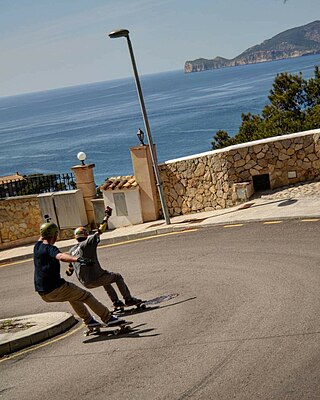
Longboarding is typically defined as a variation of skateboarding that involves a larger board and softer urethane wheels. Longboards vary in shape and size. Compared to skateboards, longboards are more stable at speed and have more traction, due to larger wheel size and lower wheel durometers. A standard skateboard is typically between 28-34 inches long, whereas a longboard may exceed 50 inches. Many longboards use trucks that have different geometric parameters than skateboards. The skateboards use "traditional kingpin trucks" while longboards often use "reverse kingpin trucks." This hardware change is the key element in the increased stability that longboards offer.
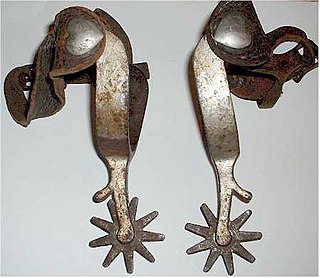
A spur is a metal tool designed to be worn in pairs on the heels of riding boots for the purpose of directing a horse or other animal to move forward or laterally while riding. It is usually used to refine the riding aids (commands) and to back up the natural aids. The spur is used in many equestrian disciplines. Most equestrian organizations have rules in about spur design and use and penalties for using spurs in any manner that constitutes animal abuse.

Motorcycle boots are associated with motorcycle riders and range from above ankle to below knee boots. They have an outside of a typical boot but a low heel to control the motorcycle. To improve motorcycle safety, motorcycle boots are generally made from a thick, heavy leather and may include energy absorbing and load spreading padding, metal, plastic and/or composite materials to protect the motorcycle rider's feet, ankles and legs in an accident. For use in wet weather, some boots have a waterproof membrane lining such as Gore-Tex or SympaTex.

Dirtsurfing is the sport of riding a Dirtsurfer brand inline board. This new Australian boardsport is correctly known as inline boarding because Dirtsurfer is a trademark protected brand name.

Coleo is a traditional Venezuelan and Colombian sport, very similar to a rodeo, where a small group of llaneros (cowboys) on horseback pursue cattle at high speeds through a narrow pathway in order to drop or tumble them.
A freestyle skateboarding trick is a trick performed with a skateboard while freestyle skateboarding. Some of these tricks are done in a stationary position, unlike many other skateboarding tricks. The keys to a good freestyle contest run are variety, difficulty, fluidity, and creativity. This is an incomplete list, which includes most notable tricks.
A flip trick is a type of skateboarding trick in which the skateboard rotates around its vertical axis, or its vertical axis and its horizontal axis simultaneously. The first flip trick, called a kickflip but originally known as a "magic flip", was invented by professional skateboarder Rodney Mullen.

A slide is a skateboarding trick where the skateboarder slides sideways either on the deck or the trucks.

Wakesurfing is a water sport in which a rider trails behind a boat, riding the boat's wake without being directly pulled by the boat. After getting up on the wake, typically by use of a tow rope, the wakesurfers will drop the rope, and ride the steep face below the wave's peak in a fashion reminiscent of surfing. Wakesurfers generally use special boards, designed specifically for wakes.
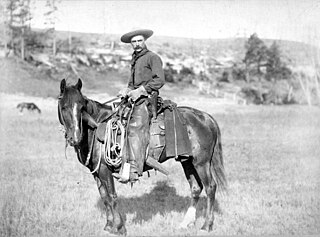
Western riding is considered a style of horse riding which has evolved from the ranching and welfare traditions which were brought to the Americas by the Spanish Conquistadors, as well as both equipment and riding style which evolved to meet the working needs of the cowboy in the American West. At the time, American cowboys had to work long hours in the saddle and often over rough terrain, sometimes having to rope a cattle using a lariat, also known as a lasso. Because of the necessity to control the horse with one hand and use a lariat with the other, western horses were trained to neck rein, that is, to change direction with light pressure of a rein against the horse's neck. Horses were also trained to exercise a certain degree of independence in using their natural instincts to follow the movements of a cow, thus a riding style developed that emphasized a deep, secure seat, and training methods encouraged a horse to be responsive on very light rein contact.

The jumping position is a position used by equestrians when jumping over an obstacle. It usually involves what is known as the "forward seat" or "2 point" because the rider's legs provide two points over which the rider's weight is balanced on the horse. It was first developed by Captain Federico Caprilli. This involves the rider being centered over his or her feet, with the stirrup leathers perpendicular to the ground. Continuing a line upwards from the stirrup leathers, the head and shoulders fall in front of the line, as do the knees and the hips fall behind it.

Bareback riding is a form of horseback riding without a saddle. It requires skill, balance, and coordination, as the rider does not have any equipment to compensate for errors of balance or skill.
This glossary of skiing and snowboarding terms is a list of definitions of terms and jargon used in skiing, snowboarding, and related winter sports.
















